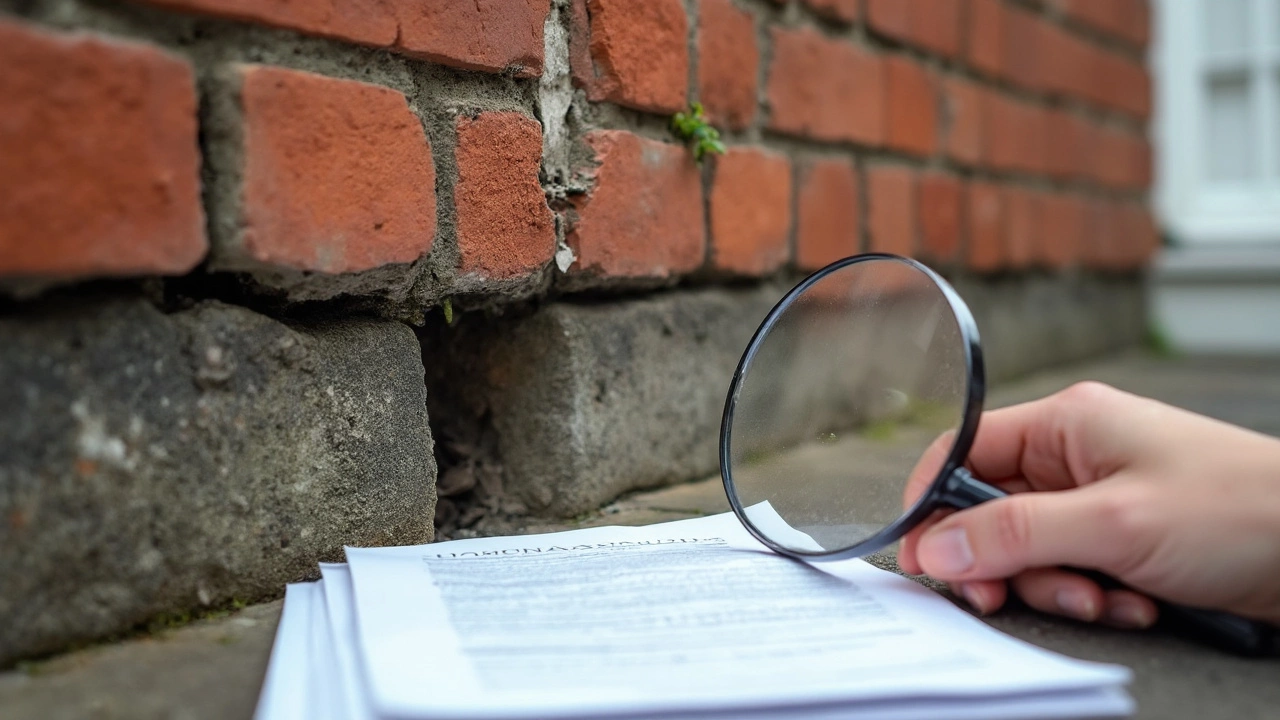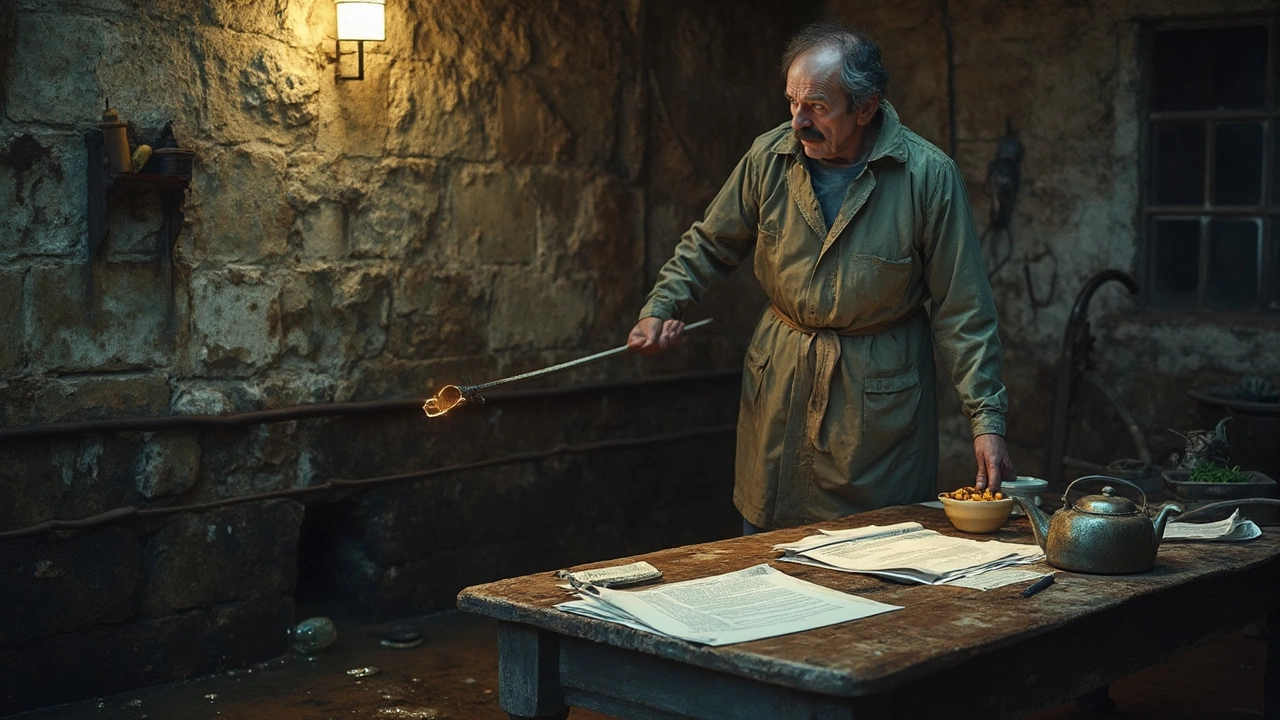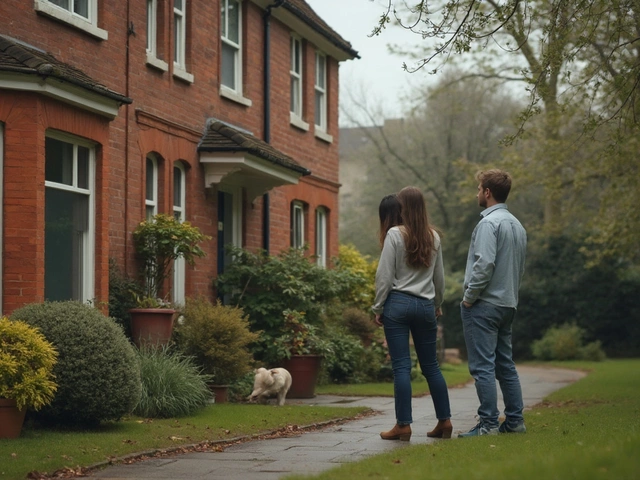Ever notice a weird damp spot on the floor or a musty smell you just can’t shake? That could be a broken pipe under the foundation—and it’s trouble nobody wants. Repairing these pipes gets pricey fast, possibly running into thousands before you even address water damage above ground. So, the big question: Will homeowners insurance save you, or are you stuck with the bill?
The truth is, it’s not a simple yes or no. Most policies cover “sudden and accidental” water damage, like a pipe that bursts out of nowhere. But there’s a catch: if the damage built up slowly or you skipped basic upkeep, chances are you’ll face a denial. Insurers dig into fine print—words like ‘gradual’ wear, ‘lack of maintenance’, and ‘slow leaks’ pop up a lot in their reasons to say no.
Before you panic about seeing cracks or soggy carpets, check your policy. Every company does it a little differently, and ‘foundation leaks’ aren’t always called out by name. Knowing where you stand could save you a headache, and maybe a lot of money too.
- Broken Pipes Under Foundations: The Real Problem
- What Homeowners Insurance Usually Covers
- Common Scenarios: Are You Actually Protected?
- How Insurers Decide Coverage
- Steps to Take After Discovering a Leak
- Tips to Avoid Claim Denials and Costly Repairs
Broken Pipes Under Foundations: The Real Problem
There’s nothing quite like discovering a puddle forming in the middle of your living room or suddenly realizing your floors seem to have a bounce that wasn’t there a month ago. Broken pipes under the foundation—sometimes called slab leaks—don’t just mess with your plumbing, they can threaten the whole structure of your house if you don’t act fast.
Here’s what’s happening: water lines or sewer pipes run under your concrete slab or crawlspace. Over time, these pipes might crack, corrode (especially if they’re made of older materials like galvanized steel), or even burst due to shifting soil, tree roots, or just plain wear and tear. Once a pipe breaks, the water has nowhere to go but up—into the soil, your foundation, and your home’s flooring. The longer it sits, the worse the damage. Mold, warped floorboards, and even foundation shifting or sinking can all come next.
Check out how common this is—according to a 2023 data report by the National Association of Home Builders, over 15% of foundation repairs in the U.S. directly involve plumbing leaks or broken pipes under slabs. That’s not rare at all.
| Issue | Potential Consequence | Typical Repair Cost Range |
|---|---|---|
| Broken pipe under slab | Water damage, foundation cracks | $2,000 – $10,000+ |
| Slow plumbing leak | Mold, wood rot, higher water bills | $1,000 – $5,000 |
| Major burst | Structural shifting, flooding | $5,000 – $50,000 |
Spotting these leaks early is huge. If you notice a sudden drop in water pressure, a spike in your bill, or hear water running when nothing’s turned on, don’t wait. Get it checked out ASAP.
- Keep an eye on your water bill for odd jumps.
- Walk around your house and feel for warm spots (hot water line leaks can heat your slab).
- Listen for the sound of running water when no taps are open.
- Check for mildew smells or unexplained dampness on floors or carpets.
The hardest part? These problems are almost always underneath where you can’t see. That’s why getting the right help—and knowing if your homeowners insurance actually covers these surprises—matters so much.
What Homeowners Insurance Usually Covers
Let’s get into the nitty gritty of homeowners insurance and broken pipes. Your policy pretty much always covers water damage from a pipe that bursts suddenly and makes a mess. Say cold weather makes a pipe snap and you’ve acted quickly to fix it—most insurers pay for the cleanup and structural damage, up to your policy limits. But here’s where folks hit surprises: the pipe itself is rarely covered. Weird, right? They’ll often cover the damage around the busted pipe but not the cost to dig up your concrete and swap out that chunk of plumbing.
And if you’re thinking about long-term leaks that happened slowly or problems that could’ve been fixed with regular maintenance, insurers are mostly out. If there’s mold from a slow drip, or old, rusty pipes finally give out after decades, you’re likely out of luck with your claim. Maintenance issues and gradual leaks almost never get a payout.
Here’s a quick snapshot of what your standard policy may (and may not) handle:
- Sudden, accidental pipe bursts—usually covered
- Water damage to floors, walls, and belongings—covered
- Repairing the busted pipe itself—not covered (most of the time)
- Damage from poor maintenance or gradual leaks—not covered
- Foundation repair for water damage—sometimes, but rarely for the pipe repair itself
Check out the comparison table below to see how this plays out in real life claims:
| Scenario | Is Damage Covered? | Is Pipe Repair Covered? | Is Foundation Repair Covered? |
|---|---|---|---|
| Pipe bursts suddenly (cold snap) | Yes | No | Maybe (if water damaged foundation) |
| Pipe leaks over months, unnoticed | No | No | No |
| Accident during repairs (contractor hits pipe) | Yes (sometimes) | No | Maybe |
| Pipes freeze but don’t burst (no damage) | No | No | No |
Bottom line: Your homeowners insurance is your friend for sudden messes, not slow ones. Always review your ‘Perils’ and ‘Exclusions’ section. If you see words like “sudden,” “accidental,” or “gradual,” that’s your sign to dig deeper. When in doubt, ask your agent to walk you through a real-world broken pipe scenario instead of relying on vague policy language.
Common Scenarios: Are You Actually Protected?
So, you're staring at a water stain crawling along your floor, or your basement smells like a swamp, and you wonder: will insurance step up? It totally depends on how the damage happened. Here's the real breakdown.
If a pipe suddenly bursts under your slab because of a freeze or pressure spike, you’ve got a shot at getting help from your insurer. These sudden plumbing disasters usually qualify as “accidental and unexpected” events—exactly the sort of thing most policies are designed to fix. Repairs to the foundation, though? That’s trickier. Most policies pay for tearing out and repairing the slab just to access the broken pipes, but not for other foundation problems unrelated to water damage.
Now, if the pipe under your home has a tiny leak that drips for months, causing deep cracks or mold, you’re probably out of luck. Nationwide, data shows about 45% of water damage claims are denied because the leak was considered ‘gradual.’ Insurance companies will call it lack of maintenance, even if you didn’t know the pipe was leaking. Ouch.
Check out this quick table to see how typical policies treat different situations:
| Scenario | Usually Covered? | Notes |
|---|---|---|
| Pipe bursts suddenly, soaks foundation | Yes | Policy covers water removal & repairs; slab access may be included |
| Long-term slow leak causes damage | No | Viewed as maintenance—claim likely denied |
| Foundation shifts, breaks pipe | Maybe | Depends on the cause—earth movement is usually excluded |
| Earthquake or flood cause pipe damage | No | Needs special coverage/rider for those hazards |
Don’t forget, standard homeowners insurance doesn’t cover damage from earthquakes or floods either. You’ll need separate riders or a policy upgrade for those. And, fun fact: most policies cap coverage for “access” repairs—so you might get the pipe fixed but get stuck paying part of the foundation work bill yourself.
The smartest move? Keep records of home maintenance and don’t ignore small warning signs. Reacting early can be the difference between a covered claim or an expensive headache.

How Insurers Decide Coverage
If you’ve ever filed a claim for a broken pipe under your foundation, you probably noticed it’s not a simple rubber-stamp process. Insurance companies look at a pile of factors before they pay up—or not.
The first thing they check: Was the damage sudden or did it creep up over time? If a pipe suddenly bursts and floods your living room, the odds are way better that you’ll get help. Slow leaks don’t usually count. Insurers want proof the problem was a surprise, not something you ignored for months.
Next up is the cause of the damage. Most policies specifically mention “sudden and accidental” water leaks, but that doesn’t always cover every situation under the homeowners insurance keyword. For example, if the pipe broke because of rust, age, or tree roots squeezing it apart, you’re likely looking at an exclusion. The source matters just as much as the mess it makes.
Insurers also review maintenance records. If you didn’t keep up repairs, that’s a fast track to denial. A lot of adjusters will even check for signs you tried to patch up leaks yourself or skipped professional help. Their logic’s simple: insurance isn’t a substitute for taking care of your home.
Here’s a chunk of real fine print, straight from the Insurance Information Institute:
“Most homeowners policies cover water damage that is sudden and accidental, but damage resulting from lack of maintenance, gradual leaks, or construction defects is typically excluded.”
To figure out if you’re covered, companies send an adjuster. They’ll inspect the damage, ask for your side of the story, and often bring in plumbers to pinpoint the real cause. If you can show clear evidence, like recent bills for plumbing inspections or repair, it gives your claim a better shot.
- Document everything right away: take photos, save receipts, and note when the pipe failed.
- Don’t start repairs (unless you have to stop active flooding) before the adjuster sees the scene—it can mess up your claim.
The bottom line? Insurers want solid proof of what happened and why. If it’s sudden and well-documented, you have a fighting chance. If it smells like forgotten upkeep, expect a tough road ahead.
Steps to Take After Discovering a Leak
If you stumble on water damage, don’t just mop it up and hope for the best. Quick action makes a real difference—insurance companies like to see that you acted fast, and it can prevent more damage from spreading.
- Shut Off the Water Supply: Don’t waste time. Find the main shutoff and close it. This stops more water from leaking out and flooding your place. Most water shutoff valves are by the water meter, often in your basement or crawlspace.
- Protect What You Can: Move any furniture, rugs, or electronics out of the wet area. The less stuff gets ruined, the less you’ll have to claim or replace.
- Take Lots of Photos and Videos: Document everything right away. Snap pictures of the leak, damp walls, and anything else affected. Good documentation helps with your homeowners insurance claim—without proof, adjusters might push back fast.
- Call a Plumber: Don’t DIY foundation leaks. Get a licensed plumber to pinpoint and stop the leak. Many will use equipment like electronic leak detectors or cameras to find the exact spot under the slab without tearing everything up.
- Contact Your Insurance Company: Report the leak and start your claim as soon as you can. Provide all your photos, plumber reports, and any notes about what you did. The faster you get everything submitted, the less delay on your claim.
- Prevent Mold: Use fans and a dehumidifier to keep things dry—mold can start growing in just 24-48 hours if things stay wet. Mold isn’t always covered, so don’t give your insurer a reason to deny extra costs.
Plumbers report that about 9% of homes leak more than 90 gallons per day. The table shows how fast things can get out of hand:
| # of Hours | Gallons Leaked | Potential Damage |
|---|---|---|
| 1 | 4 | Damp floor, minor staining |
| 12 | 48 | Carpet/floor soaking, wall moisture |
| 24 | 96 | Structural wood wet, risk of mold |
| 72 | 288 | Mold growth and drywall damage |
No two leaks are exactly alike, but fast action almost always pays off. Make sure you keep receipts for any emergency work done—the insurance company might reimburse you if your homeowners insurance policy kicks in.
Tips to Avoid Claim Denials and Costly Repairs
Insurance companies love to find reasons to deny a claim, so staying ahead of problems (and having solid proof of upkeep) makes a real difference. When it comes to broken pipes under your foundation, here are some ways to save yourself from headaches and rejected claims.
- Document everything. Take photos and videos of your plumbing, foundation, and any problem spots once a year. After repairs or inspections, ask for written reports and keep those handy. This way, you can show the insurance company you haven’t neglected the place.
- Schedule regular plumbing checks. Most plumbing pros suggest an inspection every two years, but if your home is older than 30 years, do it yearly. Undetected leaks can grow into much bigger issues, which insurers like to call “maintenance problems.”
- Respond to small issues right away. Noticed lower water pressure, random wet patches, or higher water bills? Don’t wait. Quick fixes cost less and give you a paper trail for the insurance company.
- Know your policy. Get clear on what your homeowners insurance does and doesn’t cover. If “foundation leaks” are missing from the policy, ask about extra coverage or endorsements. Sometimes a few bucks more per month makes a huge difference after a disaster.
- Use licensed pros. DIY repairs sound cheaper, but unlicensed work can void your policy or cause more trouble down the road. If the insurer finds out you didn’t use a professional, they may flat-out refuse to help.
Got a claim? Call your insurer right away, but also line up an independent plumber or foundation specialist to document what happened. That second opinion can help if your adjuster tries to downplay the damage.
| Inspection Type | Average Upfront Cost | Likelihood of Claim Acceptance* | Detection Rate of Hidden Problems |
|---|---|---|---|
| DIY Check | $0 - $50 (tools & time) | Low | About 30% |
| Licensed Pro Inspection | $150 - $400 | High | Over 70% |
*Based on claims data from a 2023 insurance industry review
Staying sharp about your home’s plumbing doesn’t just keep water out of your living room—it’s a smart way to get insurance working for you when you need it. Keeping clear records and tackling problems early are the real game changers for homeowners insurance claims.





